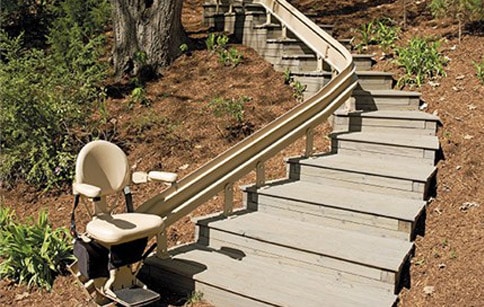Over seven-million homes have some sort of adaptive aids installed, such as stairlifts. Before you rule out the idea or run out to buy a lift, know the dos and don’ts of stairlifts and how to make prudent decisions when in the market for mobility aids and equipment.
There are some misconceptions regarding stairlifts that impact those unwilling to look further and learn more. A stairlift can increase autonomy and preserve independence in the home, while also preventing potential injury that can occur when trying to climb stairs.
For temporary rehabilitation or long-term mobility, pay heed to some of the dos and don’ts of stairlifts:
Don’t assume a lift is an eyesore. Don’t assume a stairlift in the home is an eyesore; stairlifts have come a long way and now are designed to fit seamlessly and cohesively with your home interiors and style. Furthermore, if you are concerned about others in the home navigating the stairs around the stairlift, don’t be. Most lifts feature seats that can fold up and into the lift, making the stairlift sleek, streamlined, and easy to move past on the stairs.
Don’t allow others to alter or augment your lift. Do not allow anyone other than mobility professionals to install, repair, or remove your lift. Never allow someone to make changes or augment the lift, which could be dangerous and may void or compromise an existing warranty.
Do research the costs. Do your homework regarding the costs of a lift; don’t assume a stairlift is cost prohibitive. There are grants, programs, and insurance carriers that cover the costs of a stairlift for both temporary and permanent conditions; talk to a mobility expert before ruling out a lift in your home.
Do be wary of used stairlifts. Be careful when contemplating used stairlifts; when trying to curb costs, don’t buy lifts that are more than ten years old. It is simply unwise and possibly unsafe.
Do consider renting. There are some scenarios that make renting a stairlift the practical solution. Talk to mobility vendors in the area about leasing or renting lifts for temporary conditions, short-term rehabilitation, or post-operative recovery.
Don’t rule out a lift due to your environment. Don’t rule out a lift because you don’t think your home is conducive to a stairlift; talk to an expert, first. Things like curved stairways, outdoor steps, or steep risers can all be overcome with the right lift and professional installation services.
Do wear your seatbelt. When you finally use your stairlift, make sure that you wear the seatbelt as recommended. This will prevent a potential fall and subsequent injury on the stairs.
Don’t lean or tilt. Also, don’t tilt or lean your body while using the stairlift. Sit with your spine against the seat-back, if possible, and don’t lean or reach during transfer. Have your installer demonstrate proper usage and operation.
Do pay attention to weight-limits. Stairlifts have weight capacities and limits as any equipment or device does; don’t carry passengers on the lift and watch what you carry up and down the stairs. Pay heed to your lift’s weight-limits to ensure safe usage, fine performance, and to prevent potential damage or injury.
Don’t clutter the stairs. Do make a habit of keeping the stairs clear for safety. You should also extend this protocol to the platforms, landings, and areas around the lift at the top and bottom of the stairs. Make sure pets and small children are out of the way before using the lift.
Do try before you buy. If possible, try the lift before you make a buying decision. Also, beware of buying online for this very reason. You may find certain features, like the seat or belt, to be more pragmatic or comfortable in one model than another.
Don’t rule-out future needs. Don’t buy a stairlift without a mobility assessment first. This is typically done by the mobility vendor when evaluating your needs and the best device for your home environment. This also helps point toward any future needs that could impact your selection and save you hassle later.
Do buy from reputable mobility vendors. It cannot be reinforced enough: only work with reputable mobility vendors when making an investment in a stairlift. Trying to curb costs with online sales and second-hand equipment may cost far more down the road. Read the customer feedback to find a merchant that stands behind their stairlift and that will provide service and support after the sale.
Got mobility issues? You’re not alone
It is estimated that over seven million people in this country have adaptive home devices, like ramps, hand-rails, and stairlifts. Don’t assume that only a few have invested in the life-changing accessibility that a stairlift can provide. Would you benefit from a stairlift in your home?
When you are ready to answer that question, come to see the mobility experts for a comprehensive needs’ assessment. Don’t rule out a stairlift when you – or someone you care for – struggle with mobility issues. Learn more today.
President, Husband, Father, Grandfather Graduate of UC Davis- Bio Sci Major- Go Aggies! Jeff has extensive experience in all of Pacific Mobility’s products and services, and specializes in accessibility products as well as stairlifts, ceiling lifts and custom wheel chairs. His hobbies include spending time with family, gardening, mountain biking, exercising and off road motorcycle riding.
24 years as Owner/President of Pacific Mobility Center – selling, installing, and servicing stairlifts, porch lifts, ceiling lifts, pool lifts, handicap ramping, specialty wheelchairs, scooters, power wheel chairs, and other power mobility devices
Certified Environmental Access Consultant since 2008
Licensed General Contractor since 1998
Certified Aging in Place Specialist since 2016
Board Member for Home Access Professionals
Member of Association of Members of the Accessibility Equipment Industry (AEMA)




